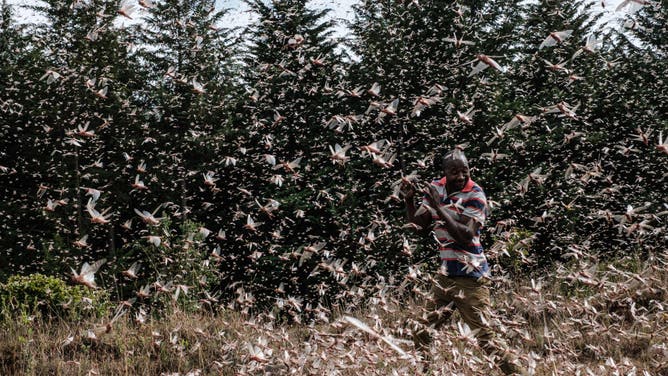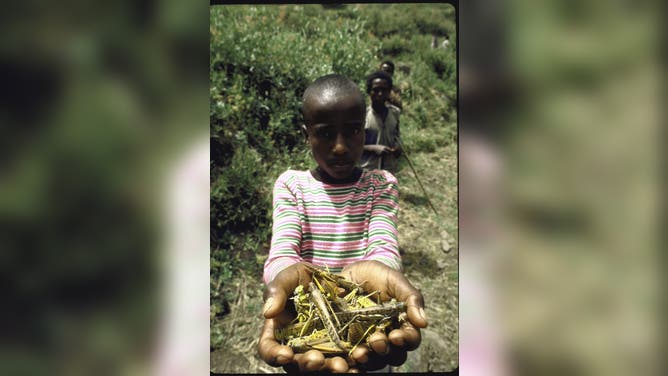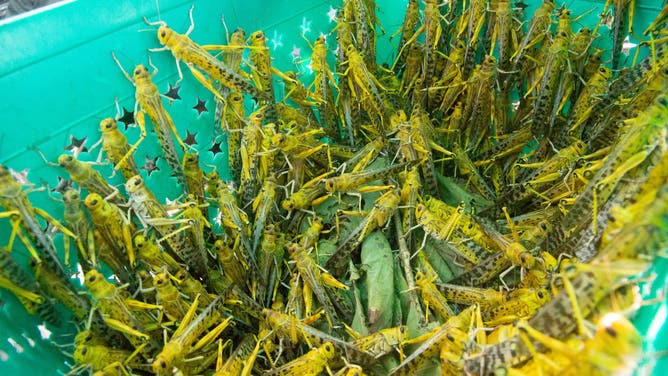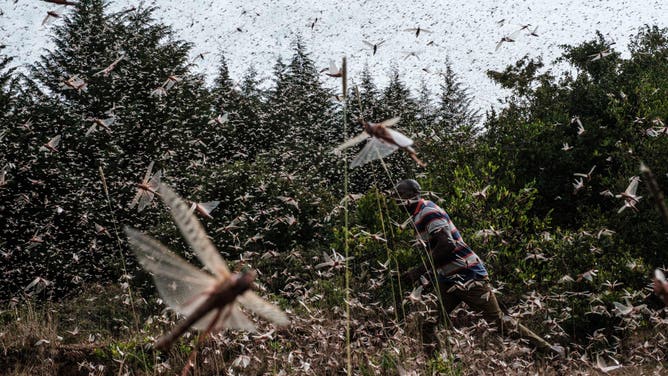Biblical plague-of-locusts threat linked to weather, climate extremes
Climate patterns like El Nino and La Nina take rain into areas that don't usually get it and that helps the spread of destructive locusts.
Watch: Swarms of locusts feast on African crops
File: In 2020, swarms of locusts attacked crops across villages in South Sudan, Africa. The World Food Programme said that threatened food supplies for 25 million of the world's most vulnerable people. Watch as men try to beat back the invaders.
Synchronized locust attacks sound straight out of the Old Testament but will become an increasingly more common reality with a changing climate, according to research.
Widespread locust outbreaks are aligned with wind and rain extremes. Research suggests synchronized attacks by locusts could become more common with a changing climate and lead to famine across Africa, the Middle East and South Asia. The authors projected locust habitat to expand by at least 5% by the end of the 21st century, even assuming further cuts in greenhouse gases.
"In recent years, there has been a notable expansion of locust hotspots to areas where they were historically uncommon," the study out of Stanford University and the National University of Singapore said. "In a warming climate, projected future increases in extreme events will render it increasingly hard to prevent and control locust outbreaks."
2024 IS THE YEAR OF THE DOUBLE CICADA EMERGENCE: A ‘SIMULTANEOUS EXPLOSION OF BUGS’

File: A picuture taken on February 9, 2021, shows a local farmer walking in a swarm of desert locusts in Meru, Kenya.
(YASUYOSHI CHIBA/AFP / Getty Images)
Most destructive migratory pest in the world
The Food and Agriculture Organization of the United Nations (FAO) calls the desert locust the "most destructive migratory pest in the world." One can eat its own weight in food a day. One swarm covers an area of 30 miles by 30 miles.
"In one day, a square kilometer (a bit more than a third of a square mile or 247 acres) swarm of desert locusts – approximately 80 million insects – is thought capable of devouring a quantity of cropland that could supply food for 35,000 people," the report said.
Simultaneous, widespread outbreaks across long distances create not only a food crisis locally after the swarm devours crops but leads to food insecurity across an entire region by "threatening shared international resources." The insect can fly up to 93 miles in one day.
Desert locust crisis of 2020-2021

File: A child holding a few dead desert locusts.
(William F. Campbell / Getty Images)
GIANT BUG FOUND AT AN ARKANSAS WALMART IDENTIFIED AS A JURASSIC-ERA INSECT
The video above shows the swarm descending on just one South Sudan village during the "desert locust crisis of 2020-2021," dubbed by the FAO. Listen to the villagers cheer on men who try to beat back the ravenous invaders with sticks, fully understanding the tragedy unfolding. It had been 25 years since Somalia and Kenya had seen that massive upsurge, breeding uncontrolled for several seasons.
The massive outbreak started in early 2020 when millions of locusts took to the air across Eastern Africa, Southwest Asia and the Red Sea regions. FAO said that favorable climatic conditions allowed for widespread breeding. A series of cyclones (hurricanes) dropped heavy rain on areas just north of the Horn of Africa.
That was when Earth entered into the La Niña climate pattern for a rare three years in a row, before plunging into a super El Niño in late 2023. In general, La Nina brings above-average rainfall to the Sahel Desert. Conversely, El Niño leads to abnormally wet conditions in East Africa. The scientists also said the El Niño Southern Oscillation-induced droughts are precursors of outbreaks.
El Nino's, La Nina's and the Intertropical Convergence Zone's role in locust outbreaks

File: Uganda People's Defence Force soldiers open a container holding Desert Locusts they have caught on February 12, 2020 in Katakwi, Uganda. Uganda has deployed soldiers to help combat one of the worst locust infestations in the region for decades.
(Luke Dray / Getty Images)
THESE ARE THE MOST TERMITE-INFESTED CITIES IN THE US
"Mounting evidence shows that El Niño and La Niña events may increase in frequency and amplitude (strength) and are associated with larger uncertainties in a warming climate," the authors wrote. "A warming climate will lead to widespread increases in locust outbreaks with emerging hotspots in west-central Asia, posing additional challenges to the global coordination of locust control."
Flooding and strong winds, like in storms, can drive the synchronized outbreaks and spur outbreaks in new regions, the research found. The seasonal variation of outbreaks is driven by the Intertropical Convergence Zone or ITCZ. The tropical belt of clouds and storms around the world is responsible for the heaviest rainfall. It shifts seasonally from north to south. And its rain facilitates locust breeding.
What is the Intertropical Convergence Zone (ITCZ)?
FOX Weather meteorologist Jason Frazer explains the Intertropical Convergence Zone (ITCZ), the region of the Earth near the equator where the trade winds of the Northern and Southern Hemispheres come together.
"Over longer timescales, the tropical rain belt is projected to shift northward over eastern Africa and the Indian Ocean in response to climate change," the authors wrote. "This may lead to a northward excursion in the locust breeding belt, which might explain the projected northward shift in the locust habitat."
Locusts lay eggs in moist sandy soil, so rain is essential to their survival and reproduction. Eggs need soil moisture to fully develop. Rain also leads to plant growth to feed the youngsters. Localized rainfall causes locusts to gather, accelerating the formation of a swarm.
Why are locusts feared?

File: A picuture taken on February 9, 2021, shows a local farmer walking in a swarm of desert locust in Meru, Kenya.
(YASUYOSHI CHIBA/AFP / Getty Images)
The bugs, which only live for three months, breed exponentially.
"With every new generation of breeding: a 20 times increase in numbers after three months, 400 times increase in their numbers after six months and 8,000 times after nine months," wrote the FAO.
A swarm the size of New York City could eat the same amount of food as everyone in New York and California combined, claimed the FAO.
The paper points to heavy rain in the Sahel Desert of Northern Africa in the summer of 2003. This then led to prolific breeding in late August and early September.

File: A Uganda People's Defence Force soldier holds a Desert Locust on February 12, 2020 in Katakwi, Uganda. Uganda has deployed soldiers to help combat one of the worst locust infestations in the region for decades.
( Luke Dray / Getty Images)
THESE HIDDEN INDOOR PESTS COULD TRIGGER ALLERGIES AND RESPIRATORY ISSUES
"When the rains stopped in October, tens of millions of scattered individual locusts concentrated in a few areas where vegetation remained," authors wrote about the upsurge from 2003-2005 in Africa and the Middle East. "The gregarious (organizing) locusts led to four separate outbreaks that were out of control in Mauritania, Mali, Niger, and Sudan because they developed suddenly and concurrently in remote areas, prohibiting rapid detection and response."
Classifying locust outbreaks

File: Invading locusts spring into flight from ground vegetation as young girls in traditional Samburu-wear run past to their cattle at Larisoro village near Archers Post, on January 21, 2020. The outbreak of desert locusts, considered the most dangerous locust species, is significant and extremely dangerous warned the United Nations Food and Agriculture Organisation describing the infestation as an eminent threat to food security in months to come if control measures are not taken
(TONY KARUMBA/AFP / Getty Images)
During quiet years, the FAO calls it recession, and the pests stick to arid and semi-arid deserts in Africa, the Near East and Southwest Asia in outbreaks. The areas see less than 8 inches of rain a year on average.
But some years, like El Niño years, when winds drive rain into different areas, said the authors, masses emerge simultaneously called an upsurge. Plagues are "one or more years of widespread and heavy infestations." Major plagues are when two or more regions are affected at the same time.

